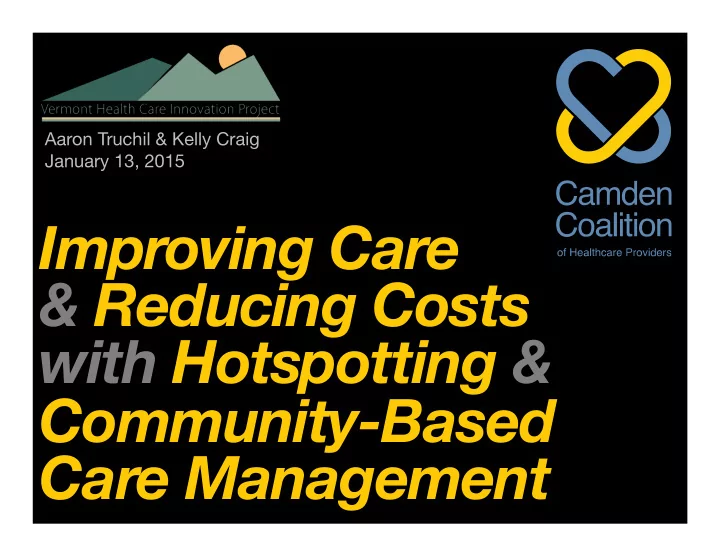

Aaron Truchil & Kelly Craig January 13, 2015 ¡ Improving Care & Reducing Costs with Hotspotting & Community-Based Care Management
Agenda afternoon session 1 CCHP’s Care Management Strategies .1 Care Planning .2 Individual Engagement .3 Community Engagement 2 Continuous Improvement and Operational E ffi ciency .1 Purposeful design and planning .2 Using data to drive operations 3 Growing your hotspotting program .1 Evaluating and Scaling .2 Telling patient stories
§ 1 Patient Engagement
IMPORTANCE ¡ BELONGING ¡ SECURITY ¡
BELONGING= ¡The ¡deep ¡desire ¡to ¡feel ¡accepted ¡ and ¡cared ¡for ¡ ¡
IMPORTANCE= ¡The ¡deep ¡desire ¡to ¡feel ¡signifant ¡ and ¡recognized ¡ ¡
SECURITY= ¡The ¡desire ¡to ¡know ¡what’s ¡coming ¡ next, ¡and ¡to ¡have ¡controlled ¡surroundings ¡ ¡
Camden Coalition of Healthcare Providers
Camden Coalition of Healthcare Providers
Stories Matter Using the worksheet provided, please write about an experience where you had a strong emotional reaction to an interaction you had with a patient. Ideally this should be something that happened within the past week. Please consider the following: • What were your test tubes? • What were the patient’s test tubes? • Name one strategy you can use when coping with this feeling in the future. Camden Coalition of Healthcare Providers
§ 1.2 Care Planning
Care Planning Camden Coalition of Healthcare Providers
Care Planning: Domains Camden Coalition of Healthcare Providers
Domains of Care Planning • Addiction • Housing & Environment • Advocacy & Activism • ID Support • Benefits & Entitlements • Legal Assistance • Education and Employment • Medication and Medical Connection Supplies • Family, Personal, Peer • Mental Health Support Support • Provider Relationship • Food and Nutrition Support Building • Health Maintenance, • Transportation Support Management, and Promotion • Patient-Specific Wildcard ¡ Camden Coalition of Healthcare Providers
Camden Coalition of Healthcare Providers
Camden Coalition of Healthcare Providers
¡ ¡ NEED ¡TO ¡WORK ¡ON ¡ DON’T ¡NEED ¡TO ¡WORK ¡ON ¡ ¡ ¡ ¡ ¡ ¡ ¡ ¡ ¡ ¡ ¡ ¡ ¡ ¡ ¡ ¡ ¡ ¡ ¡ ¡ ¡ ¡ ¡ NOW ¡ ¡ ¡ ¡ ¡ ¡ ¡ ¡ ¡ ¡ ¡ ¡ ¡ ¡ ¡ ¡ ¡ ¡ ¡ ¡ ¡ ¡ ¡ ¡ ¡ ¡ ¡ ¡ ¡ ¡ ¡ ¡ ¡ ¡ ¡ ¡ ¡ ¡ ¡ ¡ ¡ LATER ¡ ¡ ¡ ¡ ¡ ¡ ¡ ¡ ¡ ¡ ¡ ¡ ¡ ¡ ¡ ¡ ¡ ¡ ¡ ¡ ¡ ¡ ¡ Backwards Planning: Gameboard Camden Coalition of Healthcare Providers
Camden Coalition of Healthcare Providers
“Real Play”
Debrief: What did you notice? • What did you notice about the interaction? • What was hard about it? • How did it make you feel? We will call on audience members to share their experiences. Camden Coalition of Healthcare Providers
§ 1.3 Engaging Community Partners
Why Build a Healthcare Coalition? • Kelly Craig, Director of Care Management Initiatives
• Develop a cadre of resources • Build support for your program as it grows • Identify barriers to good care at a community level Camden Coalition of Healthcare Providers
Strategies ¡for ¡Engagement ¡ Outreach ¡to ¡individuals ¡as ¡you ¡make ¡connecLons ¡ • Encourage ¡them ¡to ¡invite ¡colleagues ¡ • Focus ¡on ¡frontline ¡staff ¡ • Build ¡meeLngs ¡around ¡paLent ¡case ¡presentaLons ¡ • ¡ Camden Coalition of Healthcare Providers
PotenLal ¡ParLcipants ¡ VA ¡medical ¡clinics ¡ County ¡jail ¡representaLves ¡ • • Local ¡hospital ¡physicians/nurses/ Board ¡of ¡Social ¡Services ¡(local ¡ • • social ¡workers ¡ Medicaid ¡office) ¡ VisiLng ¡nurse/home ¡health ¡ Pharmacies ¡ • • agencies ¡ Behavioral ¡Health ¡providers ¡ • Durable ¡medical ¡equipment ¡ • FQHCs ¡ • providers ¡ Other(s) ¡ • Nursing ¡home ¡and ¡sub-‑acute ¡ • rehabilitaLon ¡representaLves ¡ Wound ¡care ¡clinics ¡ • Care ¡management/care ¡ • coordinaLon ¡agencies ¡ Homeless ¡service ¡providers ¡ • HIV/AIDS ¡service ¡providers ¡ • Camden Coalition of Healthcare Providers
§ 2 Purposeful design & planning
Purposeful Design and Planning
Camden’s Health Information Exchange
Web-based Event Triggering & Data Capture
Real-time Feedback Loops: Weekly Scorecards
Ongoing Patient Engagement 168 Days 38 Days Week 1 Week 10 Days Since Last Engagement
Ongoing Patient Engagement s r u o H 0 Week 11 Week12 Week 13 Week 14 Week 15 Week 16 Week 17 Week 18 Week 19 Week 20 Week 21 Week 22 Week 23 Week 24 Week 25 Week 26 Week 27 Week 28 Week 29 Week 30 Week 31 weekly sta ff hours with patients
§ 3 Evaluating & demonstrating success
§3.1 Why is evaluating difficult?
having data
patients w/ complexities = complex intervention
finding an appropriate comparison group ~ ~
regression to the mean
it takes time! 12 1 11 10 2 3 9 8 4 7 5 6
§3.2 Choosing an appropriate timeline
Program Timeline Piloting & Early Evaluation Scaling Planning More Robust & Data Evaluation: Analysis Randomization & Qualitative Dialogue
§3.3 Two frameworks in dialog
Randomized Trials
Healthcare Delivery Studies Medical Studies 80% 20%
Clear, credible results on causal e ff ects Why? Helpful in attracting sustainable funding and scaling a program When? Timing – not too early and not too late Time, expertise, and funding to do it right Sample Size Key Randomizing before or after consent? Issues Data (what’s collected administratively? -available for the control group?)
CCHP’s Care Management RCT Standard of Care Key Outcomes: reduced re-hospitalizations and ED visits in 12 month period following discharge current N = 220 / 800
Findings :
Qualitative Evaluation
Why ? Useful for describing complex phenomena Explores the how, and why, behind an effect or phenomenon Gives more recognition to the individuals in the processes
How ? Interviews gathered & coded, become Data from “She talked to “They showed which me as a me how to we person, not as bring myself extract a patient” back” Themes
Finding: The Heart of Healthcare: The Role of Authentic Relationships in Caring for Patients with Frequent Hospitalizations Charlotte Weisberg, BA, Margaret Hawthorne, MPH, Marianna LaNoue, PhD, Jeffrey Brenner, MD, and Dawn Mautner, MD, MS
Recommend
More recommend